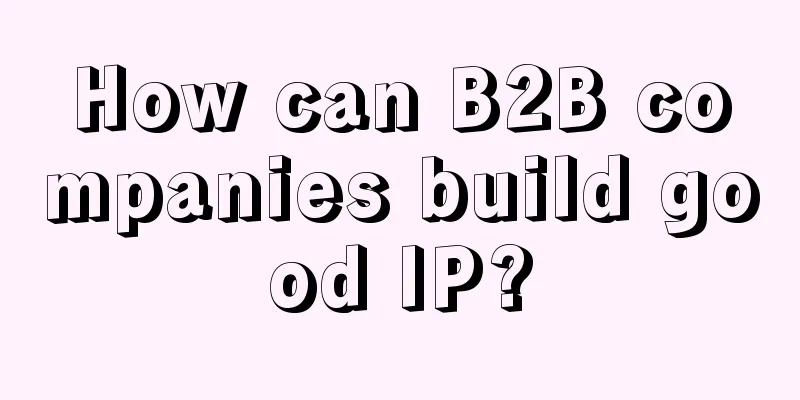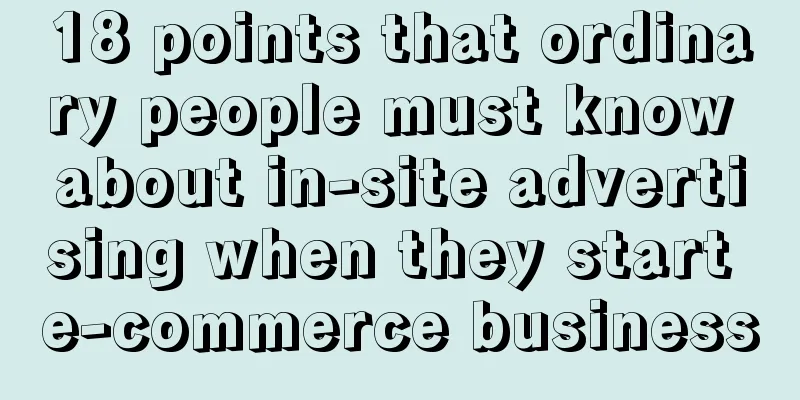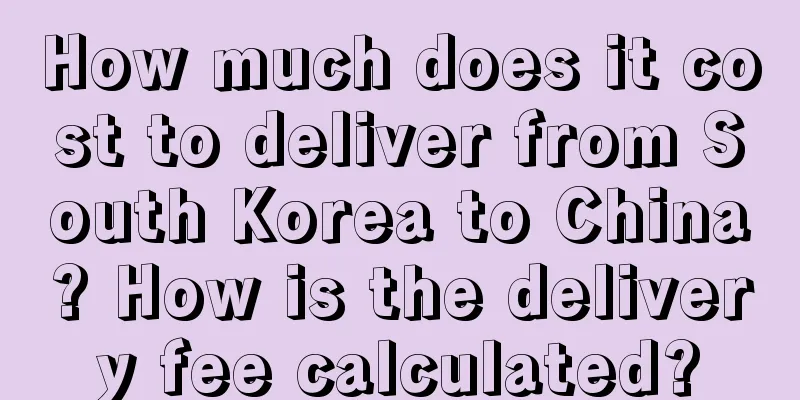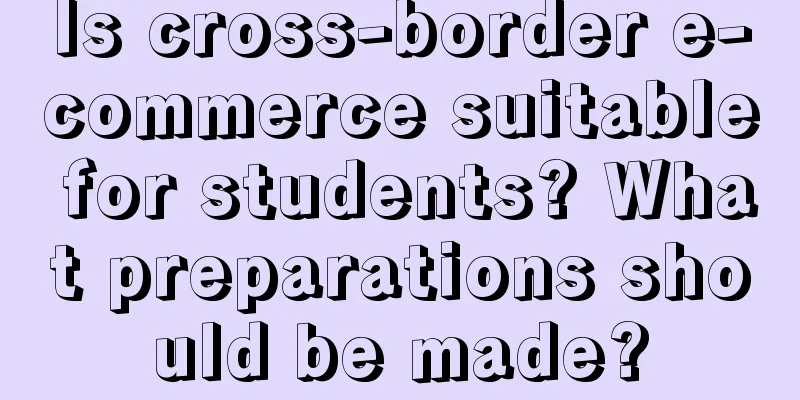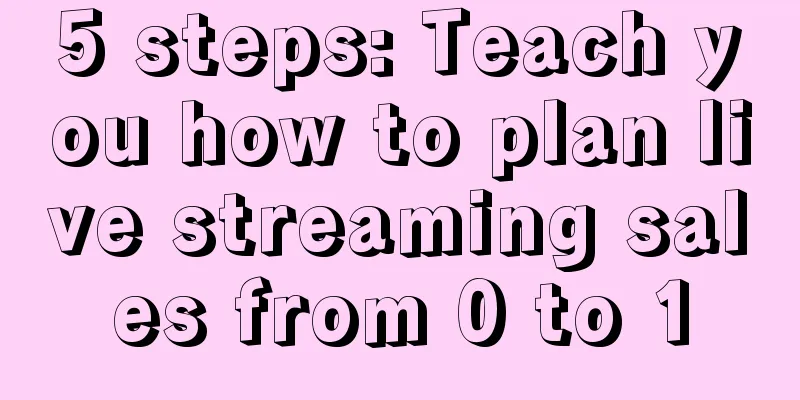How to plan a private domain event from 0-1 (Workflow of the planning stage)
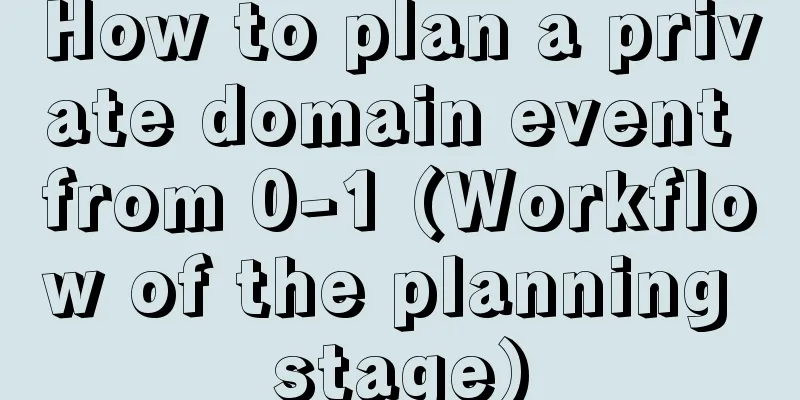
In the private domain marketing system, how to plan an effective private domain activity. It can be said that in private domain marketing, activities are indispensable! Even a very critical one. Whether it is the private domain's new traffic, user activation and retention, or the final monetization conversion, activities are indispensable. It is no exaggeration to say that the operation of the private domain itself is inevitably accompanied by various types of activities, large and small. 1. How should we plan an event?First of all, we need to realize that the activities mentioned here are in the context of private domains, not marketing activities in the traditional sense. Therefore, the starting point of the underlying logic of activity planning in the private domain system is to clarify what goals the company hopes to achieve through this activity. This is the most critical point. For example, when we plan a private domain event, do we hope to increase the number of private domain users through the event? Or do we select key customers for further activation and conversion? Or is it just a brand promotion? As a private domain operator and a corporate manager, before we promote a private domain activity, we must first think clearly about the goal and important decision-making issues. You know, strategic laziness cannot be compensated by tactics. Therefore, only when the private domain activities have clear activity goals can we break down the activity framework, required resources, key data indicators and other information. If we don’t think clearly at the beginning, and only find problems halfway through the execution, such as poor results, the business cannot be promoted. At this time, if we overturn the plan and start all over again, it will definitely be a double waste of financial and human resources. For example, if the purpose of planning an event is to increase the rate of adding fans. Then we need to systematically count how many channels the company currently has, how much traffic each channel has, what kind of target users are needed to add fans, and where these incoming fans are mainly deposited? How to divide the rights and responsibilities between departments and positions? How to design the data points of the event? In conjunction with this event, what kind of labels should be put on the target users? Including how to effectively operate these added fans after the event is over? And so on, these are all based on the key activity goal of increasing the rate of adding fans, after breaking down, you need to think about the issues. For example, if you want to boost sales at the end of the quarter through an event, then based on this key goal, all subsequent event planning content should be centered around order conversion, and all action designs should also be designed to achieve higher conversion services. As for other process indicators such as adding fans and activeness, you can temporarily give way to conversion. Okay, so clarifying the purpose of private domain activities is a prerequisite for private domain activity planning and also a key content. In addition, in actual business, I often encounter such a situation. For example, some bosses may think that a certain holiday is coming, so let's organize a promotion and post some marketing content in the group; for another example, I often see others pushing coupons in the group, and I feel that this community is quite lively, so let's design a few coupons, post them in the group, and organize some activities. Doesn't this look particularly childish? Very uncommercial? But I believe that most people have encountered this phenomenon of doing things for the sake of doing them. But really, there is no need to do this kind of activity, especially in the private domain system. It is different from traditional marketing activities, and even different from activities on public domain traffic. The users you face there may not all be old users. Many times we would say that as long as the activities continue, there will always be new users to be harvested by you, right! However, in the private domain system, the logic is completely different. You should know that most of the customers in the private domain at least have some knowledge of your products or services, or even recognize them. Therefore, compared to using short-term traffic thinking to harvest waves of activities, the key point we operators need to consider is how to make users play a higher value in the private domain traffic pool. When we plan private domain activities, we must conduct research on our own corporate private domain and current business data to determine a clear and achievable activity goal, and use this to disassemble and plan a private domain activity. For example, after we know the customer's transaction cycle and product usage cycle through data analysis, we find that customers who have not placed an order in the past six months have almost consumed their products. At this time, we can target this group and conduct a promotion conversion to stimulate customers' repurchase. So things like holiday marketing and hot spot marketing are more often used as a gimmick for an event, a form of packaging for the event, but it is definitely not the underlying reason why we initiate the event. Therefore, under the private domain marketing system, the underlying logic of planning an event is to first clarify the fundamental purpose of your event. Then, based on this, we can break down the specific event strategy. And this purpose is in line with the current development status of the company's private domain and supported by existing business data. 2. What is the process of planning a private domain event?Next, let’s talk about how to plan a private domain event and what the general process is. This is the overall workflow of a private domain marketing campaign. Normally, we will first conduct an early communication of needs, and then conduct an evaluation to see if this demand is worth planning such an event. If the evaluation result is OK, then it is equivalent to a successful project establishment. The next step is to conduct a competitive product analysis, and then conduct user research. After the research is completed, it is necessary to output a detailed implementation plan. Then we need to evaluate this plan. If the evaluation result is not ideal, we need to re-optimize the plan. If the evaluation is OK, then we can start designing the poster copy. Next, we need to configure the tools, including the settings of private domain carriers and third-party tools. Next, we need to do testing. The test can generally be divided into two steps. First, we do internal testing. We can find a few internal personnel to conduct the test. Then, we will conduct a small-scale test. This step mainly involves A/B testing. For example, on the same channel, we can use different posters to see which poster has a higher click-through rate. For example, we can use different copywriting to see which one is more attractive to users, etc. After we have finished testing, we can choose content with better conversion rates and interactive effects to conduct large-scale delivery and fission. Then when the event is officially launched, we must pay attention to the fact that we still need to maintain sufficient data monitoring of the event to see if there is anything that needs to be adjusted and optimized in time during the event. Okay, finally, when the event is over, we need to conduct a project review of the event. In addition, we also need to know that after we roughly know all the work processes, what specific things should we do? At this time, we need to use a tool table called a Gantt chart. List all of our work items and schedule them. In this way, we can clearly know what needs to be done every day, what the progress rhythm is, etc. The above is a template of the Gantt chart, you can directly apply it and then adjust it according to your actual business. 3. Specific process analysisNext, let’s take a detailed look at each process step by step. How should each process be done? (Because the purpose of private domain activities is different, the strategies and contents that need to be planned and formulated in the early stage are also different. Here I only take the purpose of private domain traffic increase as an example) 1. From demand communication and evaluation to project establishmentThis step is actually quite simple. You can analyze and determine it based on your actual situation of private domain operations, corporate marketing, etc. For example, if your private domain activity goal is to increase followers, and this goal is in line with the current business needs of the company, then it’s OK! 2. Competitive product analysisAfter the project is established, we need to conduct competitive product analysis. In fact, if you have managed many fission projects, you will find that no matter what kind of fission activity it is, the underlying logic is similar! As far as fission activities are concerned, it is nothing more than task-based fission and sharing-based fission, plus a red envelope fission. The specific carriers that can be selected are social groups or official accounts. Of course, the best social group is the corporate WeChat group. Therefore, after we analyze the competitors and see how our peers are doing fission activities, we have actually set a tone for the entire event. Next, we need to plan a feasible implementation plan based on our own actual situation. 3. Output activity planBefore we output a specific implementation plan, we still need to explore the needs of target users. Since the purpose of the event is to increase the number of fans, we must understand who the users are? What are their needs and pain points? We can use third-party platforms, such as Baidu Index, WeChat Index, etc., to search for relevant keywords. See what keywords users frequently search for? What are the points that target users are most interested in? We can also look at some popular copywriting in the industry to see what those highly read copywritings are talking about, and what keywords are in their titles? Then determine what information users are paying attention to recently? And so on. These are all a relatively quick way to understand user preferences. Then we record all of this content one by one. The summary of these needs is very critical for the design of our subsequent copywriting posters, including the setting of our activity interest points and bait. Next, based on the results of competitive product analysis and the exploration of user research needs, we will begin to develop a specific and executable activity plan. A complete event execution plan generally includes several dimensions, such as the purpose of the event, the theme of the event, the time of the event, the form of the event, and the evaluation of the effect of the event. The purpose of the event is what we have said before. Every event you do will have a core purpose, whether it is to increase fans or improve conversions, or to promote products. The theme of the event is actually to give the event a gimmick, such as common holidays, such as Double Eleven and Christmas, and some special nodes, such as membership day, anniversary celebration, etc. Okay, these are relatively simple. Let's focus on the form of the event. 1. Activity formRegarding the form of the activity, it can be divided into three parts: gameplay design, path design and rule design. 1) Gameplay design First, let's look at the gameplay design. That is to determine what the core gameplay of our activity is. This also needs to be selected according to the purpose of our activity. For example, if the purpose is to increase fans, then you can choose tasks, lucky draws, red envelopes, etc. If the purpose is to increase conversions, then you can choose group games, points, etc. At present, most people who play private domain fission will choose the game method of Mission Treasure. On the one hand, this game method has a relatively long time validity. On the other hand, in addition to effectively increasing fans, it actually helps to improve conversion. And whether you choose to use the official account to carry traffic or the corporate WeChat to carry it, this game method is more suitable. The general logic is that when a user sees your poster in Moments, they will scan the code to follow you, such as following the official account, or joining the community. Generally, they choose to follow the official account, because we can set it up in the background. When a new user follows, the background will automatically pop up a script and poster, and then prompt the user to forward it to Moments to invite friends to help. If the help is successful, you can get a prize. This is the basic path of this gameplay. In fact, when the purpose of our activity is to increase fans as the first priority, it is better to choose to use the task treasure fission gameplay. Its whole process is relatively simple, the effect of increasing fans is also relatively fast, and it is more applicable to most industries. 2) Design activity paths Okay, now that we’ve determined the gameplay, we need to design the activity path, which is the user’s possible behavior path during the activity. When designing this path, there are two key points:
For example, if we bind a public account, when a user follows it, the backend will automatically push a template message to the user, which can provide real-time feedback. The same is true for WeChat. Therefore, the key is to test whether the functions of your various carriers can provide real-time feedback to users. Because timely feedback can effectively stimulate users to continue to participate. Otherwise, if the user is halfway through the participation, there may be no timely feedback, and he will not know his current situation, or he will give up because he thinks it is too difficult. Therefore, this point is also very important! In addition to these two key points, when designing user paths, the length of the paths is inconsistent for different activity purposes. For example, if the core purpose is to increase fans, it is enough to deposit users into the private domain traffic pool. So its path to the step of users redeeming prizes has actually been completed. If your activity goal is to increase conversions. Then when designing the backend, you may need to add a recommendation for related sales when users redeem prizes to guide users to purchase other products. If you want to increase fans and convert, and you also want to be able to fission after that. Then you may need to combine the two paths. For example, let users settle in the official account first, and then guide them to the corporate WeChat account. The official account can directly do fission, and then when the user receives the prize, use the corporate WeChat account to make a conversion. Therefore, according to the different purposes of the activity, the path design needs to be adjusted according to the actual situation. 3) Activity rules design In fact, the content and form of activity rules are very diverse. For example, the aforementioned Taskbao can be designed with multiple levels. Each level will have corresponding task requirements, and you can also set a ranking list. Then we can make a diverse combination, such as only using the first level, or the first level plus the second level, or the first level plus the second level plus the ranking list, and so on. All are possible! Therefore, in essence, the design of activity rules is actually a threshold design for users to participate in activities. What we need to pay attention to is that the threshold of our activities should not be set too high when designing, but it should not be completely without a threshold. Why? Because if the threshold is too high, users will not be motivated to participate. And if there is no threshold at all, it will easily attract a group of people who want to take advantage of it! Therefore, the design of the threshold should be combined with the user's willingness to participate and the value of our prizes. In actual business, if we need to design multiple task level thresholds, we need to pay attention to the fact that the gap between the thresholds of different levels cannot be too large. For example, we cannot invite 3 friends at the first level and 9 friends at the second level. The gap between them is too large and users will not be able to complete it. Secondly, when setting multiple levels, the corresponding prizes need to be consistent with their value. For example, when a user completes the first-level task and finds that the prize for the second-level task is something he is very interested in, and then finds that he can get it by inviting two more people, then he will definitely be very willing to complete the second-level task. Therefore, when designing multiple task levels, we need to design the level based on user willingness and the attractiveness of the prize itself. Well, the above are the three parts about the form of the activity, which are the design of the activity gameplay, the path design and the design of the activity rules. In this process, I believe that the students must have discovered that there is a very important point in this activity, which is the setting of the prizes. In our case, it is a private domain marketing activity for the purpose of increasing fans, but in fact, no matter what the purpose of the activity is, the design of the interest point is the key factor for the success of the activity marketing. So, next we will focus on the product selection work in private domain marketing activities. The product selection here does not only refer to the product you are going to sell, but also refers to your prizes, which are the baits of your activities. In particular, if the purpose of your activity is the same as in our case, which is a private domain marketing activity aimed at increasing followers, then the setting of bait becomes more important. 2. Selection of welfare products/bait in private domain selectionAt this point, you may find that there is something very crucial in this process, which is our bait. In private domain marketing activities, there is a rough classification of products suitable for use as bait. Generally speaking, we can divide bait into four types: the first type is virtual products, such as common information packages, tool kits, courses, coupons, etc. The second type is physical products, such as trial packs, experience products, or other small gifts, etc., and then there is another type that is related to services, such as providing 1-on-1 business consulting, member rights services, etc., which are service products. The last type is the simplest and crudest, cash red envelopes. Generally speaking, products suitable for use as bait can be divided into the above categories. So how do we choose the right bait in actual business? The key is to combine our own business goals and the inherent properties of different types of bait products. What does it mean? Let's take a look at it first. In fact, you will find that these four types of bait products may have different effects. For example, virtual products and services may be more inclined to attract relatively accurate users. Once the users are more accurate, the overall traffic may not be particularly good. If physical products, especially cash red envelopes, are used as bait, the traffic will definitely be very large, but the user accuracy may not be so accurate, and it may even attract a group of wool parties. Therefore, different types of bait products may attract different user attributes, which will have different impacts on the subsequent operational conversion. So we need to think clearly about what our core purpose is at the beginning of planning an event? Do we want to attract targeted fans? Or can we accept general fans? Secondly, normally, the greater the traffic, the lower the conversion rate! Although this is not absolute, it is basically the logic. Well, if we want to increase the traffic scale to a greater extent, but don’t want to give up the conversion rate completely, after all, no one wants to attract a group of non-target users by private domain diversion, right? In this case, we can refer to this case: This is a snack e-commerce company. The core purpose of their private domain activities is to attract traffic to the private domain traffic pool, but at the same time, they hope to bring certain conversions. I believe that this kind of mentality is a common phenomenon in most companies in actual business, right? That is, I have a core purpose, but I am reluctant to give up another key data indicator, such as conversion rate. Okay, so when we planned this event, we mainly used two methods. First of all, there is the help of forwarding in circle of friends. There are three thresholds in total, namely inviting 3, 5 and 9 people respectively. Secondly, during the product selection phase, that is, when we were using bait, we took a shortcut. First of all, for the first tier, our prize is a 10-yuan coupon with no threshold. You will find that although it is a coupon, it is originally a virtual product, right? But because it has no threshold, it is equivalent to a cash red envelope. In this way, more users can be attracted to participate to the greatest extent. Then in the second and third tiers, the prizes are still coupons, but the coupons at this time are not threshold-free, but have certain usage conditions. The 30-yuan coupon requires a minimum consumption of 60 yuan, and the 50-yuan coupon requires a minimum consumption of 90 yuan. It is equivalent to a 50% discount and a 44% discount respectively. The benefit of this design is that after ensuring more traffic comes in, for interested users, after completing the tasks of the next two thresholds, it can be effectively integrated with the business of the enterprise itself, which has a certain help in user conversion. Okay, so for those who want to increase their followers and achieve a certain conversion effect when doing activities, you can refer to this method and effectively combine several products with different attributes to ensure the final effect of the activity. Finally, regarding the selection of bait products, the core is still the same sentence, that is, we must start from our goals and combine them with our user needs. Our bait must match the needs of users and then combine them with our goals. Do we want to increase fans in the short term or to convert? If we want to convert in the back end, then the bait in the early stage must be selected to match your conversion needs. We can give priority to virtual or service prizes, because these two types of products can actually be well combined with our business. If you want to increase your followers, then in the short term you can use physical prizes or cash red envelopes. This method can quickly achieve fission and increase your followers. Then, through certain back-end designs, you can guide users to convert and pay. Of course, you can also combine the two methods and make adjustments and optimizations based on actual business conditions. Let me add a sentence here: If you want to know more about private domain product selection, you can follow me. Okay, the above are the precautions for bait selection. Let's continue to talk about the content of the activity plan. After clarifying the purpose, theme, time, and form of the activity, including specific gameplay, paths, rule design, etc., and determining the specific bait selection, basically an initial plan is completed. The next step is to make fine adjustments and optimizations based on the actual situation, such as adding a section on costs, or a section on the estimated effect of the activity, etc. I won't talk about this for now. 4. Event poster copy design1. Poster copy design processGenerally speaking, the design of poster copy also has a certain process. It does not mean that you can directly make a poster right away. It first needs to locate the target users. That is to say, you need to know clearly what kind of users your poster is for. Do you know who the users are? Next, we will refine the information collected during our previous user research, and then combine it with the content of our event to determine what your title, subtitle, selling point, etc. are? After these contents are determined, you can communicate with the designer, for example, to determine what specific style to adopt, what the general layout is like, and what the key points need to be highlighted. After you give it to the designer, he can design a poster that meets the requirements as much as possible according to your requirements. Generally, when designing a poster for an event, we will design A and B versions, so that we can test it later to see which version has the best effect. This is a general workflow for poster design. 2. 7 elements of good newspaper copywriting designAs for poster design and how to refine the specific poster content, the key here is the following 7 elements! No matter what industry you are in, what product you have, whether you are doing fission drainage or pure publicity and promotion, the design of the poster cannot be separated from these 7 points. 1) First is user positioning Although this element is not directly reflected in the content of the poster, it determines everything about the entire poster. You should know that the Internet is actually a circle. Private domain marketing is essentially marketing to more people of the same type, or in other words, people in the same circle. Therefore, the design of your poster must conform to the identity characteristics of the target user. 2) Main title The main title is the most important key point of a poster. A good title can often attract users' attention immediately. The main title needs to find a user's "attraction point", that is, it can hit the user's pain point and refine the needs. If the main title cannot catch the user within 3 seconds, then this poster is basically useless. The following three points need to be paid attention to when creating the main title: First, it must be concise and clear: the main title should generally not exceed ten words, and should include the keywords that cause the user the most pain, or the keywords that have the strongest incentives. The second copywriting should be as short, concise and fast as possible: compact and direct, so that people can understand it at a glance without having to think about what you are writing. The characteristic of fast copywriting is that it is completed quickly. For example: 10 ways to write conversion copy that makes users go viral, 10 days to master core skills, 15 days to become a photography expert, etc. Emphasize that the time or learning amount is small, but the presentation effect is high. Here is a little trick, if possible, it is best to use Arabic numerals, because normal people are more sensitive to numbers than words. Third: Highlight and enlarge the theme: Users should be able to see the title at first glance and quickly receive the information you want to express. The text should be large. If you post it on Moments, the size of the thumbnail in Moments is limited. Therefore, in the poster design, users should be able to clearly see the theme content and be attracted by it without clicking on the large picture. 3) Subtitle copy The subtitle needs to echo the main title and is more of a supplement to the main title. The subtitle can be the selling point of the product or the content (refined) that users can get by participating in this activity. It is not necessary to have a subtitle, depending on the specific situation. 4) Content information Including product content, outline, selling points, etc. For example, if you are designing a physical prize, you need to let users know what this product is and what are the highlights. If it is a virtual product, such as a coupon, you also need to let users know what the value of this coupon is and how much value it can deduct. In fact, the core is to let users be willing to spend money or energy to participate in the event through content information. 5) Endorsement For example, who organized this activity? Which brand? Or, like many online education platforms, they often put photos of IP teachers on them. The reason is the same, in fact, it is to increase the trust of users. 6) Benefit setting It is best to set up benefits with a sense of urgency. That is, the poster must show the benefits, and the benefits must also have a certain sense of urgency. For example, limited-time promotions, limited-time group purchases, etc. In this way, a sense of scarcity is created, so that users have a mentality of taking action immediately. 7) Guidance hints For example, add a gesture next to the QR code, or tell the user that they can get something else by scanning the code, etc. This action can guide the user to pay attention to scanning the code and participate in the event. Don't underestimate this kind of guidance hint. In actual business, I found that whether there is this point in the poster can affect the scanning rate by at least 5%. So the design of poster copy is actually about paying attention to various details. Well, the above are the 7 key elements of poster copy design. In fact, the design of posters must be combined with human nature to create some marketing packaging. For example, most human nature is actually lazy, or loves beauty, or is greedy for cheapness and loves to show off. So when we design, we can focus on these core points. For example, by comparing some data on the poster, let the user feel how good this thing is for him. For example, by using the herd mentality, tens of thousands of people are rushing to buy such words, so that users can take action immediately. 3. Content of the speechIn addition to the poster design, the content of the speech is not very complicated. The extraction of the speech content generally includes three points: The first one is: the content of our promotion, including your product’s selling points, welfare bait content, etc. Secondly, there are user testimonials, including user feedback, user reviews, etc. The third is guiding content, such as guiding people to follow public accounts, follow corporate WeChat accounts, or guide users to share on WeChat Moments. Basically, for a private domain marketing campaign, the content of the script is the above three parts. Then, based on our link, we will see which key links require interaction with users. For example, if a user follows an official account and a company’s WeChat customer service, you can combine and output the above content in these places, such as promotional content + guiding content, or promotional content + user testimonials. In addition, one thing that needs to be noted is that during our entire marketing process, every time a user completes a behavioral action, we need to give him feedback, that is, tell him what he needs to do next. For example, after the user follows the official account, we need to push a sharing poster and let him promote it in the circle of friends. For another example, after the user completes the help, you can tell him to follow the company's WeChat customer service number to receive the activity reward. This is the specific wording design. The core is to design based on the key nodes in the marketing activities, or user touchpoints, so that users can clearly know what stage they are currently in, what they need to complete, what kind of prizes they can receive, etc. You can sort out these contents and make them as simple and clear as possible. That's it! 5. Tool ConfigurationYou need to know how to conduct activities under the private domain system. The selection of tools is very important. For example, when we determine the activity goals, we need to design activity tracking points and plan customer tags. If this part of the tool support is missing, there will be no tracking points for customer visits, and we will not know how many PVs and UVs the main activity page has, and which ones are old customers and which ones are new customers. Or if there is a lack of tag tracking support, the group of customers who participated in the event will not be found in the private domain pool later, and we may not even know whether the customers are added through online activities or through natural traffic from offline stores. Without understanding the customer composition in the private domain pool, refined operations are out of the question. The configuration of the tool is mainly aimed at two aspects. One is to carry out corresponding tool configuration based on the event planning itself, which specifically includes the basic functional configuration of all private domain carriers involved in the event process. For example, the message template settings in the background of the official account, the background settings of the enterprise WeChat customer service, and if there is a community involved, then you need to build a basic group, etc. And according to the type of activity, you need to match different tools. For example, for fission activities, you need to configure fission tools, and for lottery activities, you need to configure lottery tools. For example, the ranking list that may be involved in the group buying activity may require such a third-party tool to perform a user ranking, etc. In addition to the activity itself, because we are a private domain activity, we also need to configure corresponding tools based on the private domain user asset management level, such as user tag management, user behavior tag tracking, etc. There are many tools on the market for private domain marketing and all have complete functions. I don’t recommend it here. You can try it yourself and find one that suits you. VI. Activity TestNext is to enter the event testing process. You should know that whether it is event planning or something else. In the private domain marketing system, testing is essential! The main content of the test can be divided into three things:
Basically, whether it is internal testing or external small-scale testing, we focus on these points. We adjust and optimize the execution part of the entire activity based on the test results. When all the contents are relatively stable, we can start to officially launch the event. VII. ConclusionThe above is about the process of private domain marketing from 0-1 event planning, of course it is only the planning stage. The final execution level has not yet been involved. So whether it is for the event, or for the company, brand owner, and traders themselves, these are just preliminary work. After the event is officially launched, there is still a lot of work that needs to be paid attention to. For example, tracking the overall data of the event, from preheating and promotion, to launching and then finishing, etc. I will share these contents when I have time in the future. In fact, no matter what type of activity you plan, the general process, and the design of the core links, this is the way to play, at most some specific details will be different. This requires us to make flexible adjustments and applications in the actual business and according to the actual situation. For example, if you are selling private domains with the purpose of increasing product sales, it may also involve what your original private domain conversion model is. For example, if you are in the form of live broadcast of community + video accounts, then you also need to pay attention to community operations, live broadcast operations, and even paid investment flows. Even for some retail companies, private domain activities themselves involve offline. When formulating activity plans in the early stage, it may also include store shopping guide training, store activity exposure after the event is launched, business execution, data feedback, etc. Different companies, different development stages, and your original private domain strategy will be different in the event planning and execution stages. Author: Source: WeChat official account " " This article and published on Operation Pattern. Reproduction is prohibited without permission. The title image is from Unsplash, based on the CC0 agreement |
<<: Find the hot article! Disassemble the hot article! Become the hot article!
>>: Code it up! When creating a user portrait, these 5 questions are the most important?
Recommend
What kind of Amazon ads can increase exposure? What are the ways to promote on Amazon?
In the fiercely competitive e-commerce market, how...
Corporate Strategy VS Brand Strategy
This article shows how Xiangpiaopiao seized the ma...
How to reduce ACOs on Amazon advertising? What are the tips?
Amazon now has many ways to promote itself. When y...
What is Amazon's customer service phone number? Where can I contact customer service?
Like Taobao, Amazon also has official customer ser...
How to attract customers when opening a new store? Here are five tips for opening a new store
If you want to attract customers when opening a ne...
What is a data analysis project and how to do it?
Many students who are responsible for data will wa...
Where can I find Amazon product conversion rates? How can I improve them?
Amazon merchants need to promote their stores afte...
Different Women's Day copywriting, no need to please women like this!
As the International Women's Day is approachin...
We talked to more than 10 brand owners about why it is difficult to plant grass on Xiaohongshu
Xiaohongshu has undergone a series of organization...
Gaotu, a benchmark in the private sector, rarely talks about growth: Now we must and can only tilt towards the entire domain!
In the wave of digital transformation, brand growt...
How to make a good annual plan? Think about these 3 points
In the new year, it is important to make appropria...
How much does it cost to register an Amazon store? Is it expensive?
Now the development of cross-border e-commerce pla...
What are the benefits of Amazon’s targeted advertising? How to do it well?
More and more merchants are opening stores on Amaz...
A must-have guide for TikTok marketing: Learn about Big Data Engine in one article
Do you feel lost and helpless on the road of Douyi...
"Cat One Cup" was banned across the entire network, and the frequent occurrence of chaotic script traffic has triggered new thinking
In the era of online information explosion, some s...

